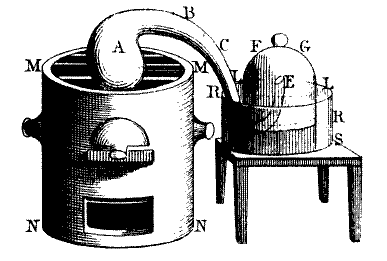Lavoisier decomposition air
Autor:
- derivative work: Cdang (talk)
- Hidrogenexp2.gif: Mme Lavoisier, uploaded by User:HappyApple
Credit:
Krótki link:
źródło:
Wymiary:
387 x 261 Pixel (13501 Bytes)
Opis:
Hand sketch engraving made by madamme Lavoisier in the 18th century featured in "Traité élémentaire de chimie" retrieved from http://mattson.creighton.edu/History_Gas_Chemistry/Lavoisier.html Lavoisier performed his classic twelve-day experiment in 1779 which has become famous in history. First, Lavoisier heated pure mercury in a swan-necked retort over a charcoal furnace for twelve days. A red oxide of mercury was formed on the surface of the mercury in the retort. When no more red powder was formed, Lavoisier noticed that about one-fifth of the air had been used up and that the remaining gas did not support life or burning. Lavoisier called this latter gas azote. (Greek 'a' and ' zoe' = without life). He removed the red oxide of mercury carefully and heated it in a similar retort. He obtained exactly the same volume of gas as disappeared in the last experiment. He found that the gas caused flames to burn brilliantly, and small animals were active in it as Joseph Priestley had noticed in his experiment. Finally, on mixing the two types of gas, i.e. the gas left in the first experiment, and that given out in the second experiment, he got a mixture similar to air in all respects. In his experiments Lavoisier analysed air into two constituents: the one which supports life and combustion, and is one-fifth by volume of air he called oxygen (Greek, oxus=acid, gen=beget), the other four-fifths which does not he called azote. This latter gas is now called nitrogen. From the two gases he synthesised something that has the characteristics of air.
Licencja:
Public domain
Więcej informacji o licencji można znaleźć tutaj. Ostatnia aktualizacja: Tue, 20 Dec 2022 07:56:17 GMT
